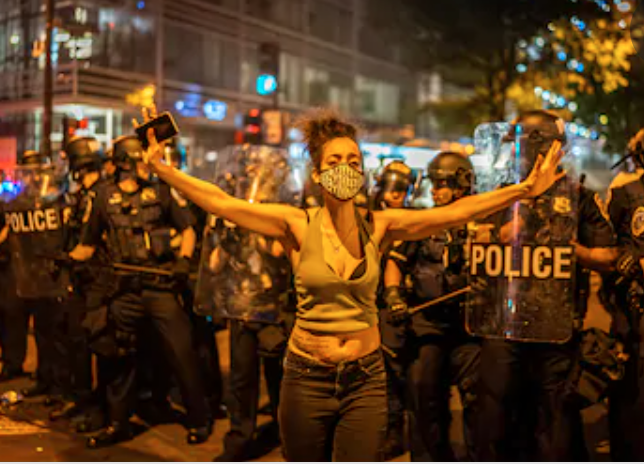A protester seen walking away from policemen peacefully. Many protesters gathered in front of the White House in Washington, DC on May 31. (Shutterstock)
(NEW YORK) — Advocacy journalists take a different kind of stance than other journalists when it comes to crafting a story. This type of writing has a different belief system attached — it is dedicated to a certain cause, where the journalist takes a direct and intentional stance. It’s a step above simply an opinion essay because the goal is to createa call to action, to call out injustice.
An example of this type of journalism was a recent report from the nonprofit Human Rights Watch, regarding new evidence showing the members of the New York City police department staged a mass arrest and assault on a group of peaceful protesters in the Bronx. The organization released a report and video showing new evidence that the police department did create a plan to stage a mass arrest in Mott Haven, a part of the Bronx, after tracking down peaceful protesters in early June.
This is a great example of advocacy journalism because it was tied to human rights and police brutality and demonstrates detailed investigative reporting. They were able to back up their arguments with evidence on the event in addition to getting testimonies from the people involved. We have discussed how objectivity is one of the foundations of journalism and while the organization has taken a stance in their advocacy, they presented an argument backed up by verified facts and sources. The video was able to give even more context to the details leading up to the event and what happened outside of what had previously been reported.
Another reason why this piece is a great example of advocacy journalism is that it does not violate the ethical standards a journalist should hold. As previously mentioned, the organization’s report did take a stance against the actions of the police, however their bias did not take away from their reporting, which was objective.
There was nothing to be left up to conspiracy theories and no statement that wasn’t supported by fact. The evidence presented told the full story which revealed the truth of what happened during that event. There was also diversity in their sourcing from the work with SITU Research firm to independent reporting. They were able to successfully follow up with their points with a variety of verifiable sources which made the report stronger.
In a world where media is increasingly less objective with commentators like Rachel Maddow, Bill O’Reilly, Alex Jones becoming people’s main source of news that is driven by their own political views, advocacy journalism can walk a very fine line between ethical journalism and opinion-driven news. The Human Rights Watch NYPD report is a strong example of how this type of journalism is both impactful and can demonstrate excellent reporting. It is possible to be an advocate for causes important to you without infringing on your ethical code as a journalist as long as you still look to uphold those ethical pillars within your writing and reporting.


